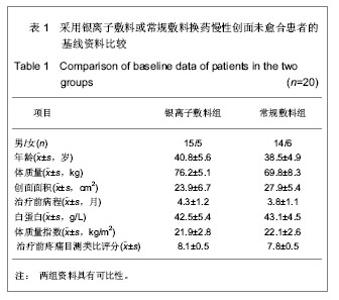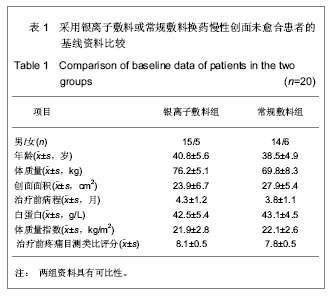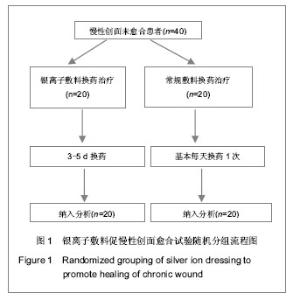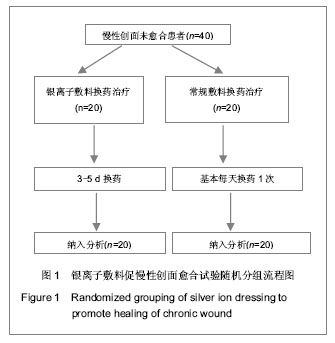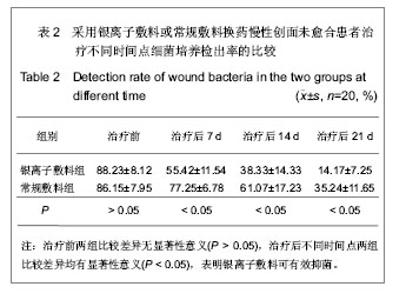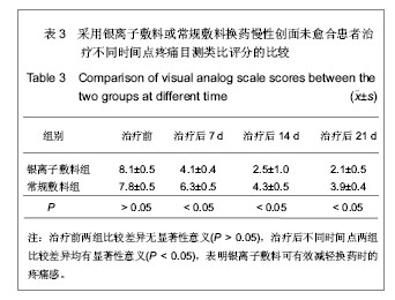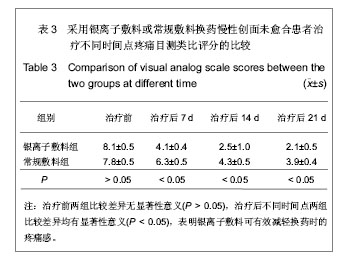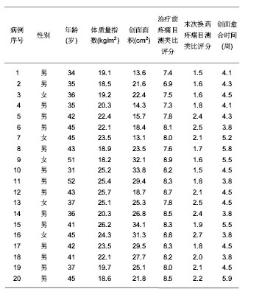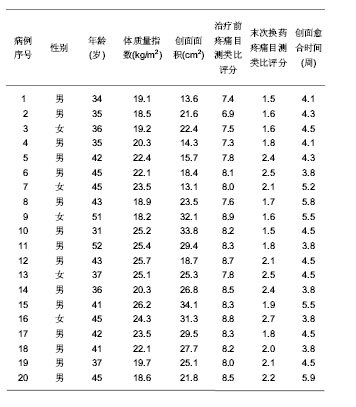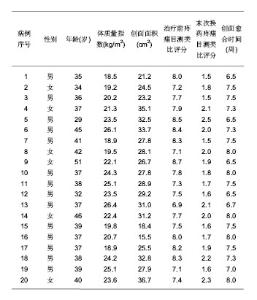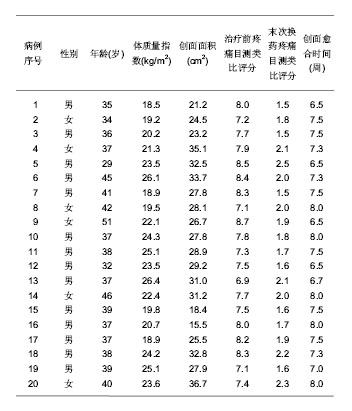Chinese Journal of Tissue Engineering Research ›› 2013, Vol. 17 ›› Issue (42): 7494-7500.doi: 10.3969/j.issn.2095-4344.2013.42.024
Silver ion dressing effects on healing of chronic wound
Liu Tao1, Xu Hai-dong2
- 1Department of Anesthesia, Tangshan Branch of Nanjing General Hospital of Nanjing Military Command, Nanjing 211131, Jiangsu Province, China
2Department of Orthopedics, Nanjing General Hospital of Nanjing Military Command, Nanjing 210002, Jiangsu Province, China
-
Received:2013-04-09Revised:2013-04-29Online:2013-10-15Published:2013-10-31 -
Contact:Liu Tao, Department of Anesthesia, Tangshan Branch of Nanjing General Hospital of Nanjing Military Command, Nanjing 211131, Jiangsu Province, China -
About author:Liu Tao, Attending physician, Department of Anesthesia, Tangshan Branch of Nanjing General Hospital of Nanjing Military Command, Nanjing 211131, Jiangsu Province, China lllt006@sina.com
CLC Number:
Cite this article
Liu Tao, Xu Hai-dong . Silver ion dressing effects on healing of chronic wound[J]. Chinese Journal of Tissue Engineering Research, 2013, 17(42): 7494-7500.
share this article
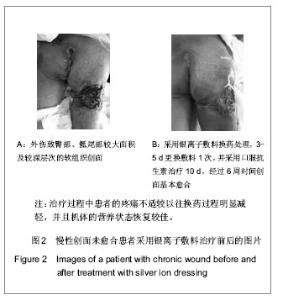
2.6 两组患者愈合速度及不良反应 两组患者均在2个月内基本愈合,试验组与对照组愈合时间分别为(4.5±0.7),(7.3±0.5)周,两组比较差异有显著性意义 (P < 0.05)。试验组与对照组的愈合率分别为(88.46±5.76)%,(55.43±7.89)%,两组比较差异有显著性意义(P < 0.05)。两组治疗组中均未发生任何不良反应。 2.7 两组患者的平均换药次数及医药费用比较 试验组与对照组换药次数分别为11.3±2.5,55.6±12.5,两组比较差异有显著性意义(P < 0.05)。 试验组与对照组总医疗费用分别为(2 178.5± 412.6),(2 215.4±231.6)元,两组比较差异无显著性意义(P > 0.05)。 2.8 典型病例 患者系中年男性,35岁,外伤致臀部、骶尾部较大面积及较深层次的软组织创面,在外院予以常规换药处理,治疗达3个月未见明显愈合。在本院治疗采用银离子敷料换药处理,3-5 d更换敷料1次,并采用口服抗生素治疗10 d,经过6周时间创面基本愈合,治疗效果满意,治疗过程中患者的疼痛不适较以往换药过程明显减轻,并且机体的营养状态恢复较佳,见图2。"
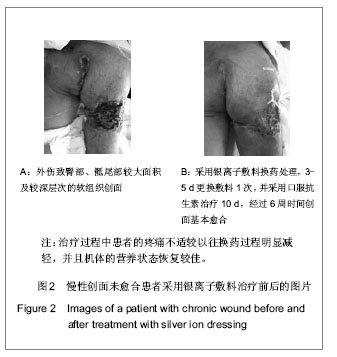
| [1] 葛小静,章宏伟,史京萍,等.藻酸盐银联合水凝胶敷料对慢性创面愈合的作用[J]. 中国组织工程研究,2012,16(3):539-524. [2] Elsner JJ,Berdicevsky I,Zilberman M.In vitro microbial inhibition and cellular response to novel biodegradable composite wound dressings with controlled release of antibiotics.Acta Biomater.2011;7(1):325-336. [3] Zajicek R,Matouskova E,Broz L,et al. New biological temporary skin cover Xe-Derma(®) in the treatment of superficial scald burns in children. Burns.2011;37(2): 333-337. [4] 丁华荣,张宪发,梁自乾,等.纳米银与磺胺嘧啶银治疗烧伤创面疗效比较的Meta分析[J].中国组织工程研究,2012,16(16): 2967-2970. [5] 李晓普,黄跃生,彭毅志,等. 纳米晶体银敷料治疗烧伤后残余创面的多中心临床研究[J].中华烧伤杂志,2006,22(1):15-18. [6] Gristock R.Silver dressings:the need for clarity.J Wound Care. 2005;14(1):30. [7] Dowsett C.The use of silver-based dressings in wound care.Nurs Stand.2004;19(7):56-60. [8] Thomas S,Ashman P.In-vitro testing of silver-containing dressings.J Wound Care.2004;13(9):392-393. [9] Thomas S,McCubbin P.A comparison of the antimicrobial effects of four silver-containing dressings on three organisms.J Wound Care.2003;12(3):101-107. [10] Slezak A,Kucharzewski M,Grzegorczyn S,et al. Study of transport properties of the polymeric membranous dressing with silver ions.Polim Med.2005;35(4):3-11. [11] 李民,刘亚明,林倩君,等.纳米银敷料对烧伤创面保护作用的观察[J].中国医师进修杂志,2006,20(5):11-13. [12] 陈炯,韩春茂,林小玮,等.纳米银敷料在修复Ⅱ度烧伤创面的应用研究[J].中华外科杂志,2006,44(1):50-52. [13] Ziegler K,Görl R,Effing J,et al.Reduced cellular toxicity of a new silver-containing antimicrobial dressing and clinical performance in non-healing wounds[.Skin Pharmacol Physiol.2006;19(3):140-146. [14] Lansdown AB,Williams A,Chandler S,et al.Silver absorption and antibacterial efficacy of silver dressings.J Wound Care. 2005; 14(4):155-160. [15] Luo G,Tang J,He W,et al.Antibacterial effect of dressings containing multivalent silver ion carried by zirconium phosphate on experimental rat burn wounds.Wound Repair Regen.2008;16(6):800-804. [16] Li J,Yan W,Jing L,et al.Addition of an alginate to a modified zeolite improves hemostatic performance in a swine model of lethal groin injury. J Trauma.2009;66(3):612-620. [17] Percival SL,Thomas JG,Slone W,et al.The efficacy of silver dressings and antibiotics on MRSA and MSSA isolated from burn patients.Wound Repair Regen. 2011;19(6):767-774. [18] Wilkinson LJ,White RJ,Chipman JK.et al.Silver and nanoparticles of silver in wound dressings: a review of efficacy and safety.J Wound Care. 2011;20(11):543-549. [19] Percival SL,Thomas J,Linton S,et al.The antimicrobial efficacy of silver on antibiotic-resistant bacteria isolated from burn wounds. Int Wound J.2012;9(5):488-493. [20] Belcaro G,Cesarone MR,Errichi BM,et al.Silver oxide ointment wound dressing in venous ulcerations: home, self-management.Panminerva Med. 2011;53(3 Suppl 1): 29-33. [21] Chen JP,Chiang Y.Bioactive electrospun silver nanoparticles-containing polyurethane nanofibers as wound dressings.J Nanosci Nanotechnol.2010; 10(11):7560-7564. [22] Blanco Blanco J,Ballesté Torralba J. Local control treatment of bacteria found present in an infected bed sore by means of a hydropolymer dressingwith ionic silver.Rev Enferm.2009; 32(10):7-14. [23] 刘仁海,高霞.含银离子敷料治疗2-3级糖尿病足溃疡42例[J].中国药业,2012,21(9):50-51. [24] 傅开兰,谢幸华. 爱康肤~(TM)银抗菌敷料对慢性感染性创面愈合效果的影响[J].佛山科学技术学院学报:自然科学版,2010, 28(4):79-82. [25] Hinman CD,Maibach H. Effect of air exposure and occlusion on experimental human skin wounds.Nature.1963;200: 377-378. [26] 陶岚.爱康肤银抗菌敷料加速感染切口愈合效果的对照研究[J].中华现代护理杂志,2011,28(4):1766-1769. [27] Kohr R.Moist healing versus wet-to-dry.Can Nurse.2001; 97(1): 17-19. [28] Driver VR.Silver dressings in clinical practice.Ostomy Wound Manage. 2004;50(9A Suppl):11S-15S. [29] Bin Ahmad M,Lim JJ,Shameli K,et al.Antibacterial activity of silver bionanocomposites synthesized by chemical reduction route[J]. Chem Cent J.2012;6(1):101. [30] Saxena V,Hwang CW,Huang S,et al.Vacuum-assisted closure: microdeformations of wounds and cell proliferation.Plast Reconstr Surg. 2004;114(5):1086-1096。 [31] 苏天兰,时利群,李伟人,等.银离子敷料在感染伤口的应用效果观察[J].贵阳医学院学报,2010,35(4):390-391. [32] Coban YK,Erbatur S,Aytekin AH. A useful combination in the treatment of toxic epidermal necrolysis: Octenoidine dihydrocholoride solution and Aquacel-Ag.Burns.2011; 37(3): 545-546. [33] Lee JH,Chae JD,Kim DG,et al.Comparison of the efficacies of silver-containing dressing materials for treating a full-thickness rodent wound infected by methicillin-resistant Staphylococcus aureus. Korean J Lab Med.2010;30(1):20-27. [34] Vogt PM,Andree C,Breuing K,et al. Dry, moist, and wet skin wound repair. Ann Plast Surg. 1995;34(5):493-499. [35] Field FK,Kerstein MD.Overview of wound healing in a moist environment. Am J Surg.1994;167(1A):2S-6S. [36] 朱守林.湿性疗法在慢性伤口处理中的应用观察[J].实用临床医药杂志,2010,14(6):67-69. [37] Bergin E,Savage C.Surviving multiple obligations through stimulation, autonomy, and variation.J Health Organ Manag. 2011;25(4):455-468. [38] Poli-de-Figueiredo LF,Garrido AG,Nakagawa N,et al.Experimental models of sepsis and their clinical relevance. Shock.2008;30 Suppl 1:53-59. [39] Berman DW,Crump KS.A meta-analysis of asbestos-related cancer risk that addresses fiber size and mineral type.Crit Rev Toxicol.2008;38 Suppl 1:49-73. [40] 陈炯,韩春茂.Ⅱ度烧伤创面外用药的药物经济学评价[J].中华烧伤杂志, 2006,22(5):377-378. [41] Guest JF,Taylor RR,Vowden K,et al.Relative cost-effectiveness of a skin protectant in managing venous leg ulcers in the UK.J Wound Care. 2012;21(8):389-394, 396-398. [42] Foglia E,Restelli U,Napoletano AM,et al.Pressure ulcers management: an economic evaluation.J Prev Med Hyg. 2012;53(1):30-36. [43] Fulton JA,Blasiole KN,Cottingham T,et al.Wound dressing absorption: a comparative study.Adv Skin Wound Care.2012; 25(7):315-320. [44] Hankin CS,Knispel J,Lopes M,et al.Clinical and cost efficacy of advanced wound care matrices for venous ulcers.J Manag Care Pharm.2012;18(5):375-384. [45] 王清华,钟文非,何萌.藻酸盐敷料的临床应用:与传统材料的特征的比较[J].中国组织工程研究与临床康复,2010,14(3): 533-536. [46] 黄国宝,张磊,张科验,等.海藻盐敷料应用于难愈性烧伤创面的随机对照[J].中国组织工程研究与临床康复,2010,14(34): 6355-6358. [47] 李晓琴,但卫华,王康建,等.体表创面修复材料的研究进展[J].材料导报,2009,23(1):374-377. [48] Manizate F,Fuller A,Gendics C,et al.A prospective, single-center, nonblinded, comparative, postmarket clinical evaluation of a bovine-derived collagen with ionic silver dressing versus a carboxymethylcellulose and ionic silver dressing for the reduction of bioburden in variable-etiology, bilateral lower-extremity wounds. Adv Skin Wound Care. 2012;25(5):220-225. [49] Cox SG,Cullingworth L,Rode H.Treatment of paediatric burns with a nanocrystalline silver dressing compared with standard wound care in a burns unit: a cost analysis.S Afr Med J. 2011;101(10):728-731. [50] Qin Y.Silver-containing alginate fibres and dressings.Int Wound J. 2005;2(2):172-176. |
| [1] | Zhang Jinglin, Leng Min, Zhu Boheng, Wang Hong. Mechanism and application of stem cell-derived exosomes in promoting diabetic wound healing [J]. Chinese Journal of Tissue Engineering Research, 2022, 26(7): 1113-1118. |
| [2] | Li Weiming, Xu Qingwen, Li Yijun, Sun Yanbo, Cui Jin, Xu Pengyuan . Deep seawater promotes wound healing in diabetic mice by activating PI3K/Akt pathway [J]. Chinese Journal of Tissue Engineering Research, 2022, 26(5): 724-729. |
| [3] | Zhao Zixi, Xu Jun, Ding Min, Li Xiwen, Zhang Jinghang, Wang Penghua. Changes of type I and III collagen and matrix metalloproteinase 2 and 9 on the wound of diabetic foot ulcer with external application of medical collagen dressing [J]. Chinese Journal of Tissue Engineering Research, 2022, 26(10): 1544-1550. |
| [4] | Zhang Zhenkun, Li Zhe, Li Ya, Wang Yingying, Wang Yaping, Zhou Xinkui, Ma Shanshan, Guan Fangxia. Application of alginate based hydrogels/dressings in wound healing: sustained, dynamic and sequential release [J]. Chinese Journal of Tissue Engineering Research, 2021, 25(4): 638-643. |
| [5] | Wen Xu, Shen Jing. Application of nano-silver antibacterial hydrogel dressing combined with recombinant human basic fibroblast growth factor on wound healing after debridement of open ankle fracture [J]. Chinese Journal of Tissue Engineering Research, 2021, 25(29): 4638-4643. |
| [6] | Liu Fang, Shan Zhengming, Tang Yulei, Wu Xiaomin, Tian Weiqun. Effects of hemostasis and promoting wound healing of ozone sustained-release hydrogel [J]. Chinese Journal of Tissue Engineering Research, 2021, 25(22): 3445-3449. |
| [7] | Chen Zhenyu, Zhang Xiaoning, Luo Yuxin, Liang Jianwei, Yan Chi. Evaluation of silk fibroin/curcumin composite film for promoting wound healing [J]. Chinese Journal of Tissue Engineering Research, 2021, 25(16): 2554-2561. |
| [8] | Zhao Xin, Shi Xin, Chen Bei, Cao Yanpeng, Chen Yaowu, Liu Xiaoren, He Yusheng, He Liyun, Li Xiying, Liu Jun. Vacuum sealing drainage enhances wound healing by up-regulating collagen type I/III ratio in rats [J]. Chinese Journal of Tissue Engineering Research, 2020, 24(32): 5122-5127. |
| [9] | Liu Yanhua, Zhu Zhou, Wan Qianbing. A drug-loading system for electrospinning wound repair: component selection and construction strategy [J]. Chinese Journal of Tissue Engineering Research, 2020, 24(28): 4465-4473. |
| [10] |
Geng Kang, Ding Xiaobin, Tian Xinli, Wang Xue, Yang Yuting, Yan Hong.
Electrical stimulation promotes wound healing and angiogenesis in diabetic rats [J]. Chinese Journal of Tissue Engineering Research, 2020, 24(26): 4152-4156. |
| [11] |
Gu Yingxuan, Huang Linfeng, Hu Xiaohui, Quan Xiaoming, Kang Liangqi, Zhou Linghan, Wang Xiaojun.
Platelet-rich plasma combined with negative pressure for chronic refractory wounds: a meta-analysis [J]. Chinese Journal of Tissue Engineering Research, 2020, 24(26): 4257-4264. |
| [12] | Liang Zhou, Wen Lichun, He Zhong, Huang Zheng, Li Kaijing, Yang Xiaoping, Liang Shihe, Pang Gexiong. Three-dimensional printing combined with virtual surgical design in the treatment of complex Pilon fractures [J]. Chinese Journal of Tissue Engineering Research, 2020, 24(24): 3786-3791. |
| [13] | Zhong Shuxian, Shi Yuqing, Yang Yalan, Li Chun. Effect of soft silicone silver ion dressing applied in burn wounds [J]. Chinese Journal of Tissue Engineering Research, 2020, 24(22): 3602-3608. |
| [14] | Zhong Shuxian, Yang Yalan, Shi Yuqing, Li Chun . Meta-analysis of platelet-rich plasma in repairing burn wounds [J]. Chinese Journal of Tissue Engineering Research, 2020, 24(14): 2291-2296. |
| [15] | Fan Shifeng, Qie Hui, Zhang Wenxuan, Hou Xiaowei, Wang Lijie, Zheng Yu. Comparison of the effects of topical application of zoledronic acid and silver nanoparticles on osseointegration of immediate implant [J]. Chinese Journal of Tissue Engineering Research, 2020, 24(10): 1547-1552. |
| Viewed | ||||||
|
Full text |
|
|||||
|
Abstract |
|
|||||
